"Unexpected Plans in Indian Himalayas, Ladakh "
Story & fine art photographs by: Brad Carlile Sept-Oct 2004
All Rights Reserved - Copyright Brad Carlile 2004
"That's the difference between being a traveler and a tourist. A tour is fixed and you are not," I was told after my 3rd major change of plans.
Things change. Impermanence is a universal that can be rewarding if you let it. This was frequently demonstrated to me this fall in the Ladakh region in the Indian Himalayas.
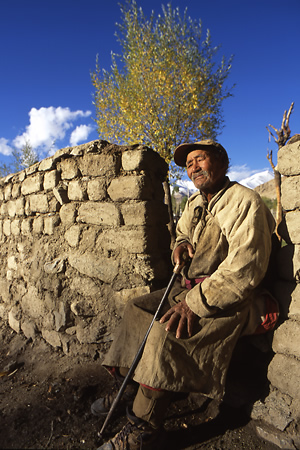
Change
Over the years, my most memorable travel experiences were unplanned. Now that I no longer fight change, amazing experiences unfold. I focus my preparation time reading about social customs. I travel with a rough plan, not a fixed itinerary.
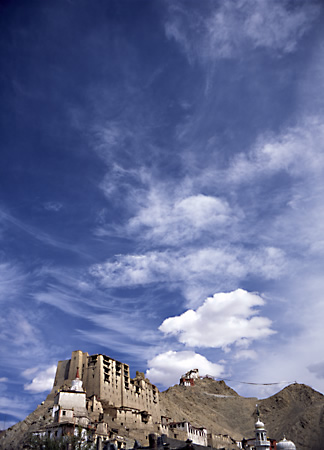
©2004 Brad Carlile
Many visit the Indian Himalayas for the wonderful people, high-altitude villages, Gompas (Buddhist monasteries), and mountain trekking. The environment of Ladakh inspires such feelings of spirituality that some also study the native Buddhism or the southern India import yoga.
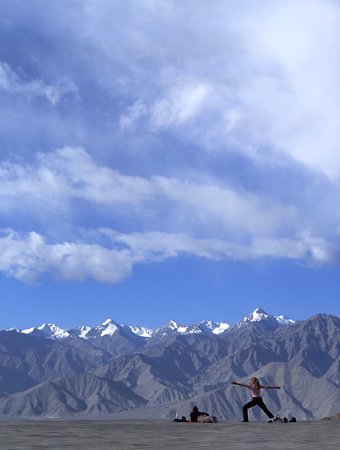
©2004 Brad Carlile
The Ladakhi regional capital, Leh, has many sights to see. It is also great base for many side trips.
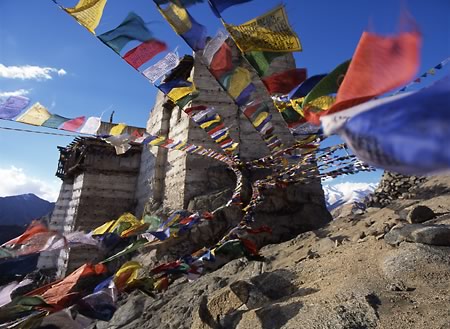
Award/Cover: Photography Annual 2005 ©2004 Brad Carlile
The first plan for a group of travelers and me was to hire a car for a one-day trip to a mountain lake called Pangang Tso.
Soon came my first major change of plans.
On the way we crossed a high pass of 17,900 feet, and yes, the air was thin. But thankfully the lake is at 14,000 feet. The air was still thin and I hadn't had much chance to acclimatize, as Leh is a mere 11,500 feet.
The precaution of taking it easy and drinking lots of water and chai (tea) helped prevent any problems.
"WOW", we all thought, this saltwater lake is a combination of the most vivid blues and most magnificent aquamarines complimented and surrounded by multi-color mountains, with snow covered peaks beyond.
Half of the group decided to stay an extra 3 days, and take a local bus back to Leh. I was one of them and, of course, I had no overnight things. Mental note to self: in the future always carry at least some contact solution.
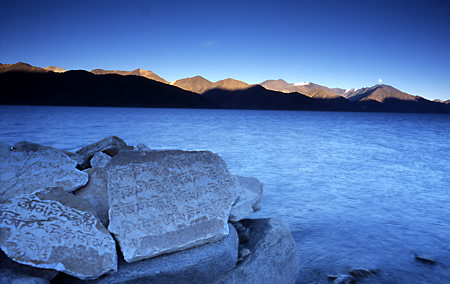
Spangmik is a small village that is the closet point to the Chinese border that India allows travelers to stay. The village provides parachute tents, layers of heavy blankets, and cooks to prepare three meals a day. It was marvelous and all of the villagers were very gracious.
As the sun travels across the sky, the lake goes through some of the most amazing blues in the palette. The day finishes in a magical sunset. The warm oranges and yellows enriched the tan mountains and then surprised us with a bright full moon rise.
At our final breakfast in Spangmik, a six grader taught me many things about his school, the others in the villages, and many other things. He also enjoyed riding his bike on the frozen salt-water lake in the winter.
Temperatures can drop to a bone-chilling -40 degrees Celsius in the winter. Which easy converts to -40 degrees Fahrenheit.
After breakfast, we go on the bus and rode it for a few miles. Suddenly, many on the bus told us that we didn't have permission to ride any further. After a few clarifying questions, we figured out that the bus would return after visiting a sensitive Chinese-border village that doesn't permit tourists.
We were told to wait for an hour on the salt flats by the tip of the lake.
Soon ten Indian army regulars posted nearby came over to invite us for chai. We give them cigarettes (I don't smoke but carry them for gifts), swap stories, laugh, and drink chang. Chang is a local barley wine/beer. After two hours the bus returned to continue the eight hours back to Leh.
Leh, Namgyal Tsemo, and Full Moon
Early the next morning, in Leh, I decided to watch the sunrise at Namgyal Tsemo, a Buddhist Gompa.
As the sun rose, I sat looking out at the prayer flags and the snow-covered mountains beyond them. As I looked to one side I saw a man trailing a 200-foot string of Buddhist prayer flags. We greet each other with "Joolay" which translates roughly into Aloha (hello, goodbye, thank you, etc.), and then other niceties in English.
He and four other men perform a ceremony every full moon that involves praying, burning incense in a fire, and tying up new flags.
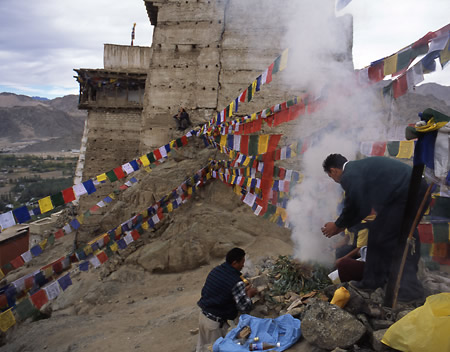
The string has prayers written on five different colored flags. He explains the symbolism of each color: green for water, red for fire, white for clouds, blue for sky, and yellow for earth. With each flap, the flags offer up prayers.
As we talk and joke around, they invite me to join the final ceremony. Three times we walk clockwise around the fire carrying barley. When we stop they teach me the chant to use as we lift the barley three times and toss it into the fire. Hopefully this will help bring a year with more peace in the world. We finish by sharing chocolate and dried fruit.
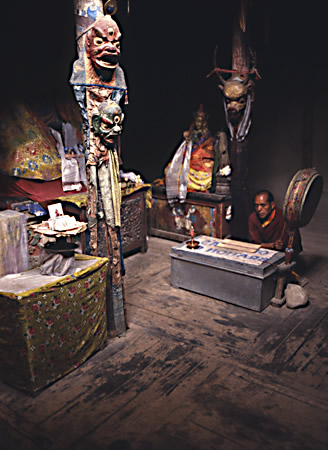
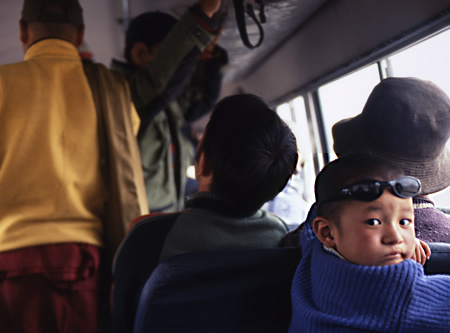
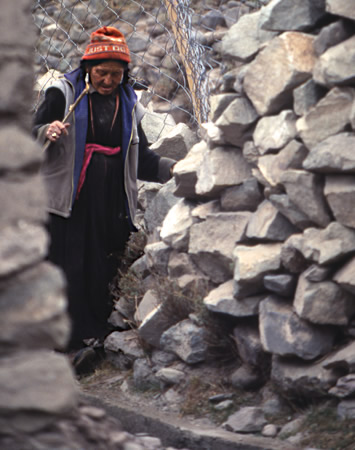
I enjoyed visiting other Gompas in the area. Tikse is a large Gompa several miles from Leh. Prayers here are announced by trumpeters blowing horns from a rooftop high above the valley floor.
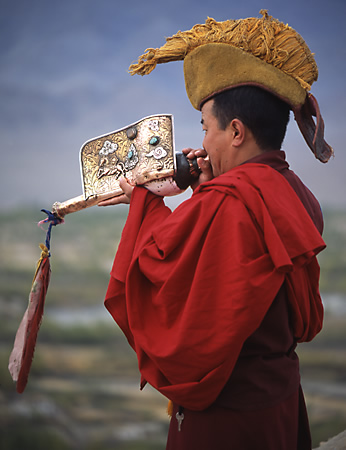
©2004 Brad Carlile
Pujas are morning prayers that the Buddhist monks perform every morning at 7. Visitors are welcome to watch from the back and listen to the chants.
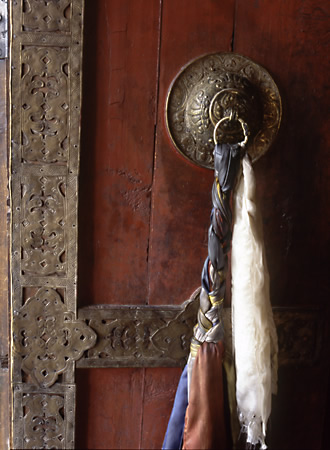
Hemis Gompa, Lama, and Change
After watching the Puja, I took a local bus to Hemis, the largest Gompa which is about 20 miles away. We arrived at 11am and I was told that the last bus left at noon. With the campground locked, I had little alternative but to hurry.
My second major change of plans was about to happen.
After walking around for an hour, I thought, "wait a minute, why shouldn't I see if I can stay with a villager?"
I ran back to the Gompa to ask two monks if they knew of someone to stay with. The older one motions I can stay with him. The younger one explains he is the Lama (read "Big Boss") and I can stay in a room next to his. "Yes", I quickly reply.
After our lunch, the Lama tells me of the Gotsang Gompa only a few miles away.
The trail to Gotsang hugs a babbling stream in the middle of a narrow valley. The golden autumn colored trees hug the stream and glow brightly in the afternoon sun. This is very inspiring. When I reach the Gompa I sit and reflect for several hours.
During dinner when I talk with the Lama, I can quickly see why he is the Lama. I'm impressed by his warm calmness, compassionate smile, and magnanimous presence.
After a very restful sleep, I awoke for the 7am morning prayers. The morning was a bit easier, as I had remember to bring contact solution for unplanned stays.
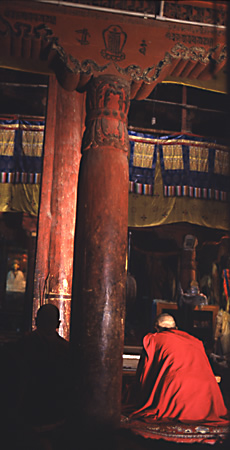
©2004 Brad Carlile
As I enter the prayer room filled with red-robed monks, I'm struck by the warm aroma of butter lamps. Being the only westerner there, they offer me yak-butter tea to sip as I enjoy this wonderful experience.
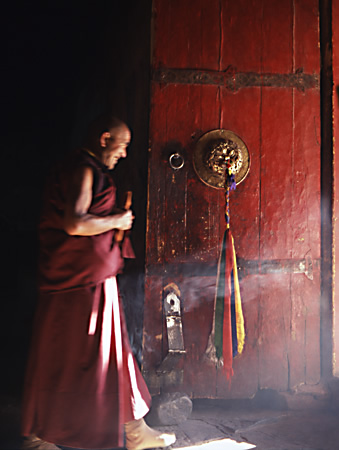
in Hemis.©2004 Brad Carlile
After saying my last goodbyes, I decide to change my plans again and add a trip to the Taktok Gompa on the other side of the Indus Valley. This beautifully decorated Gompa was built next to a cave where in the 6th century, an important Buddhist apostle meditated on his way to Tibet. I explore the Gompa with a visiting monk, who was delighted to visit this holy site.
In the village below, I find a bus. I'm surprised when the music is turned up when the bus pulls away, and many begin singing and dancing. I've never seen this before. I happened to get on a bus with many who were in the midst of a going-away party for a transferring teacher.
The bus stops at another village for another 30 minute celebration. When I go see what is going on, I talk to another waiting passenger. He offers to take me to his sister's house to drink chang. As we head into her traditional house, she greets me warmly, also calls me a brother, and instead pours the prized Arak, Ladakhi Whiskey. After good conversations over several glasses, we return to the bus with moments to spare.
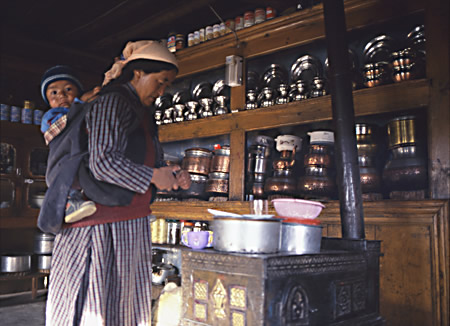
©2004 Brad Carlile
Soon came my third and fourth major change of plans.
The day I planned to travel south, I awoke to a downpour and questionable snow-covered passes. The next morning Leh was blessed with blue skies and breathtaking views of mountains covered with new snow.
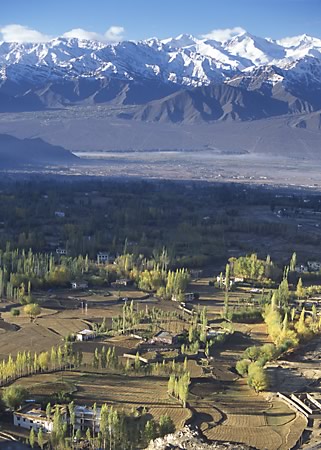
on the mountains. ©2004 Brad Carlile
A day later, I canceled with a south-bound group, to instead go north to the beautiful Nubra valley. Unbeknownst to me, snow had closed the Nubra pass. Then hours before I awoke, the pass reopened and the bus left.
Leh to Manali Highway: Tso Moriri Indian Himalayas salt water lake
A new plan took me from Leh to Manali with a great group of German-speaking travelers with whom I enjoyed many laughs. This trip included a enjoyable two night stay in a village at a saltwater lake called Tso Moriri (15,075 feet).
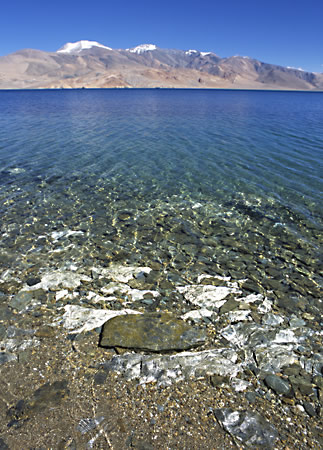
This lake is also a amazing deep blue, with lots of birds flying about, and set in a fantastic high-desert mountain landscape. The mystical beauty of the lake and the barren mountains inspires spirituality.
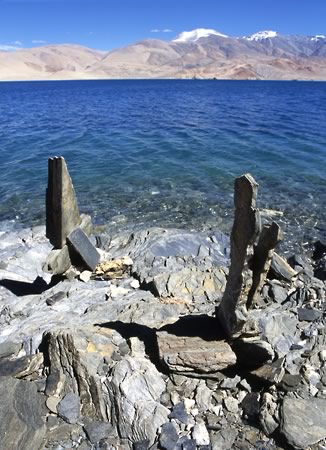
Buddhist Chorten (commemorative cairns) and Mani walls (built from stones engraved with sacred inscriptions) dot the shoreline. Our group enjoys visiting each as we walk around the lake.
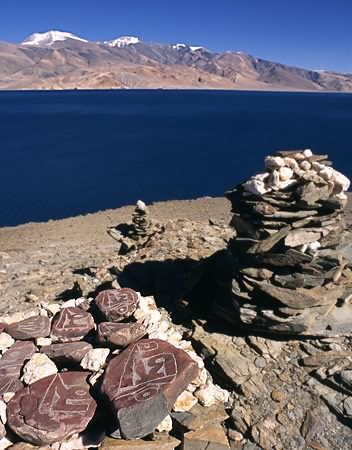
©2004 Brad Carlile
The rest of the trip on the famed Leh to Manali highway was amazing. It took us from the high moonscape-like mountains to the snow-capped peaks above the green forests around Manali.
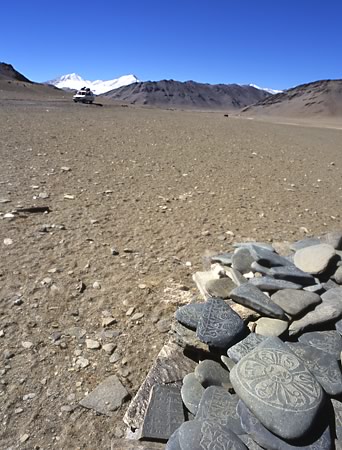
©2004 Brad Carlile
Changes can be more wonderful than any plans. My trip was enriched by learning as much as I could from the locals and embracied to the wonderful changes as they unfolded in the Indian Himalayas.
IF YOU GO: Ladakh Travel Details
Warning: Traveling in Ladakh in areas near Pakistan or China will often require tourists to get special permits. This can usually be arranged early in the morning before your travel.
The Department of State often warns U.S. citizen to defer travel. The Department believes there are increased threats to U.S. citizens in Kashmir (http://travel.state.gov). Also Look at Australian, Canadian, and UK for travel advisories. They tend to be a little more realistic than the US government.
Getting Around: Independent travel in Ledakh region is not difficult on either local transport or arranged tourist transport.
Visa: Everyone needs a visa to enter India. Going to Tso Moriri, Pangang Tso, and the Nubra valley require special permits your passport may be checked at checkpoints.
Health risks: Leh, the regional capital has one of the highest commercial airports, but its elevation of 10,000+ feet make it absolutely necessary that visitors reaching Leh from the plains of India by air, give themselves sufficient time for acclimatization before engaging in *any* physical activity. Rest, drink lots of water and tea, eat well and take it easy. This is no joke as most tourists who I meet who did not do this were sick for several unpleasant days. For other health advisories, check with a travel clinic for the latest, also see www.cdc.gov.
When to go: By October the passes start to get snow and close. Many shops and restaurants also close by the beginning of October (this used to be Mid-September). The diverse geography means that the mountainous areas can sometimes be cool.
Hotels: There are many hotels in the regional capital Leh. I liked the family run Oriental Guest House in the Changspa area near the Shanti Stupa. (tel. 253153)
Treks & Tours : Treks can be arranged through "The Nomadic Way" where they are very knowledgeable and friendly. They also arrange trips at some of the best prices around. They are located at Fort Road Leh (tel. 252258 fax. 252780).
National Geographic on Snow Leopards in Ladakh: https://www.nationalgeographic.com/travel/article/searching-snow-leopards-ladakh-india
More info: "India" (Rough Guide & Lonely Planet). I prefer the insights in the Rough Guides -- every other tourist carries Lonely Planet so you can always reference theirs if you want to see what typical tourists uses for their short list of recommendations.